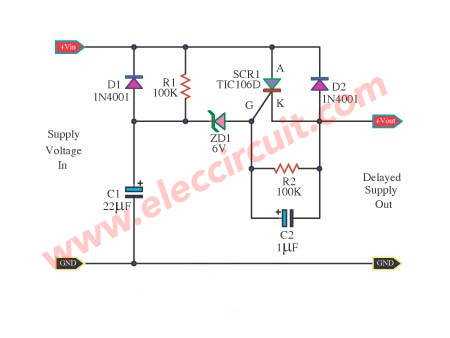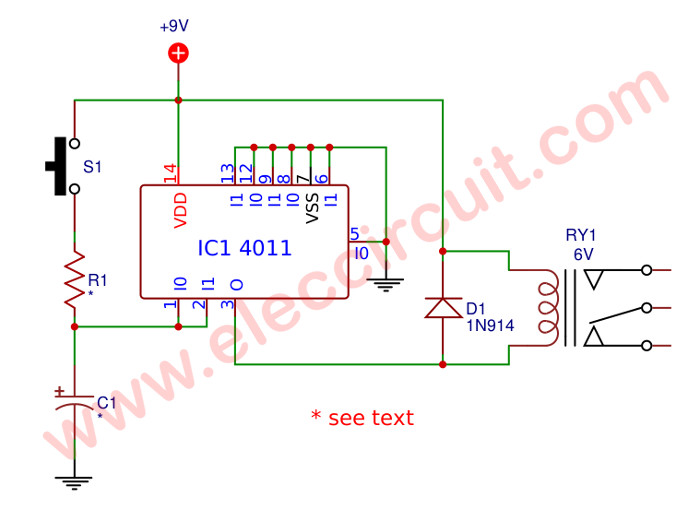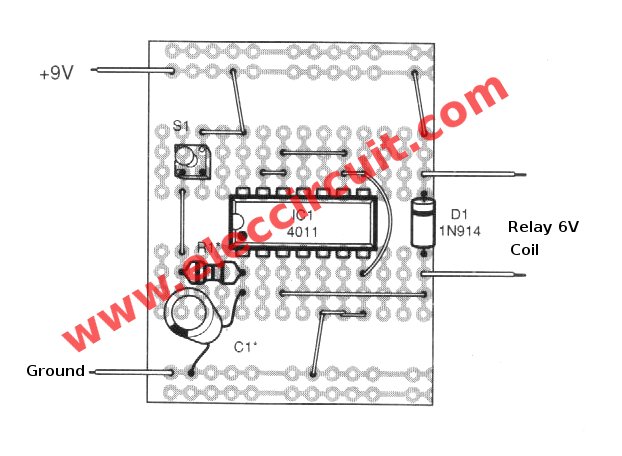The surge protection circuit is important. If there is a thunderstorm, the power goes out or the extreme power surges.
Sometimes, our electrical appliances may damage easily. A little high voltage surge may make it loses.
We can protect this problem with this circuit. When we switch on the appliances. The circuit will delay turning on it.
For example, we set the timer for 3 seconds. After 3 seconds the circuit will turn on load right now.

Simple surge protection circuit using SCR
This is a special circuit. It uses SCR that working like the relay. It is a good idea. Because of 2 advantages! First, fast switch on-off. Second, use low current in a trigger.
But it may difficult than a relay.
Recommended: How does a SCR thyristor work?
How the circuit works
In the circuit, the voltage of the power supply into the Supply voltage in the terminal.
The circuit is working. But the SCR is still stopping. Why?
The input current flows through R1 to charges to C1. In the first time, the voltage across C1 is 0V. After that, the voltage will rise up partially.
Until C1 is fully charged. So, the voltage across it is “high” state.
The current will flow through ZD1 to trigger the gate of the SCR. It turns on to connect the supply voltage input to output Delayed supply out.
Why we use it
ZD1—6V Zener diode will limit the voltage to gate of SCR, not too over!
D1,D2—diodes—protect the spike voltage backward.
C1—to set time delay.
R2 and C2 in parallel—reduce the noise to gate of SCR.
While SCR is working it may be hot. It requests a large heat sink.
‘Small surge protector for AC load’ »
Parts you will need
SCR1—TIC106D, 5A 400V SCR Thyristor; Quantity:1
D1,D2—1A 50V diodes; Quantity:2
ZD1—6V 0.5W Zener Diode; Quantity:1
R1,R2—100K 0.5W Resistors; Quantity:2
C1—22uF 50V Electrolytic capacitor; Quantity:1
C2—1uF 50V Electrolytic capacitor; Quantity:1
4011 Time Delay for Surge protector
This is a simple time delay relay circuit. It is suitable for the surge protection. It can control more loads with a relay.
When pressing the push button switch, the time delay starts. But the relay output stops now. It will run after time setting.
So it can prevent equipment damage from the surge or spike voltage.
How it works
We want a simple and small circuit. So we use the main component, 4011 NAND gate CMOS.
It is easy to do.
In the circuit, we use only one NAND gate of 4011. And we connect pin 1 and pin 2—input of IC— together, so it becomes to the inverter gate.
If we press S1, the current from a power supply flows through R1. And It slowly changes to C1. The voltage across pin 1, pin 2 and ground slowly rises up, too.
Since it is the inverter, so output pin 3 is “high” state. And the relay still turns off. Because it connects across the output and the positive supply.
After that, the current changes to C1 full. While voltage across input is a high state.
So The output is low, the relay pulls in or turns on that.
The time delay can set by R1 and/or C1.
The current of circuit is limited by type of relay that use.
Figure 1 Time delay for relay using CD4011
Calculate the discharge time delay Can be calculated by the equation
T = R1 x C1 x 0.85
By that:
T is the period of the delay in seconds.
R1 is the resistance in ohms.
C1 is the capacitance in uF.
The current of circuit is limited by type of relay that use.
Digital trigger—You can use a general NPN type transistor instead of the switch-S1. Thus, the circuit can be used to trigger signal from a computer or other circuit.
Power relay—If you want to apply to the higher voltage relays. Just need to add the output driver transistor. To be able to more load.
How to builds
This project does not use many components so can assemble on the universal PCB board. Then, the wiring and various components show the example in Figure 2.
You should assemble carefully the polarity of the electrolytic capacitors and Pin of the IC1 correctly.
Figure 2 The components layout of this circuit.
You will need components list
R1—See text — 1 pcs.
C1—See text — 1 pcs.
IC1—CD4011 Quad 2-Input NOR Buffered B Series Gate
D1—1N914 or 1N4148 —Silicon diode —1 pcs.
RL1—Relay 6V—1 pcs.
Note:
If really using you can remove the S1 with normal wire.
GET UPDATE VIA EMAIL
I always try to make Electronics Learning Easy.



This circuit will not work, when switched on the relay will stay on forever.
Pin 3 is shorted to ground, it will damage the IC !
The other output gates pins shorted to ground will damage the IC too !
PLEASE WHAT VALUE OF VOLTS OF CAPACITORS?
#4011 Time Delay for a Surge protector
Please follow my mail thank you.
Hi sunarto,
If you subscribe me,you will get mail from me.
Thanks for your member.
#4011 Time Delay for Surge protector
Hi C1 and R1? time 30s
Hi habib,
Thanks for your question.
I try to calculate simple.
30 second: If you use R1 = 1M, C1 = 33uF to 47uF
#4011 Time Delay for Surge protector
hi Thanks
If, for a long time, say 12 hours, please introduce a different circuit if the answer is no
#4011 Time Delay for a Surge protector
Hi, I assembled this circuit with a voltage of 9/5 relay is lit. With a capacitor of 0.01 and a resistor of 1 mega-ohm relay is not turned off after long hours.
thanks for your response
Hi habib,
You may try again. With using LED and resistor 330 ohms instead of Relay. This uses low current. Then, you remove S1 and use wire instead.
The LED should glow up after time goes for a few minutes.
Dear Sir,
Can you please look at this project. (link)
https://electronicsforu.com/electronics-projects/power-supply-failure-alarm
how can you make a 220VAC output on the PIEZO BUZZER?
i want to replace it with a 220VAC relay.
Please help me.
Hi, again
For this circuit, I not sure it is in you want. Do you want the spike voltage protection for your machine?
Please wait for me. I will try to check my circuit for you.
I am sorry I cannot file the circuit as you want.
sir,
please modify this circuit to have a 220VAC output at piezo terminal?
https://electronicsforu.com/electronics-projects/power-supply-failure-alarm